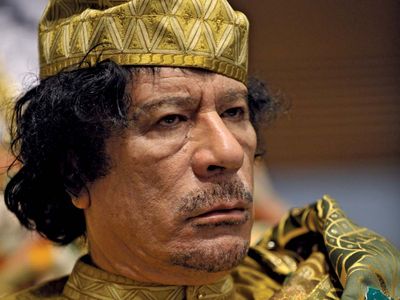
Muammar Gaddafi rose to power in Libya in 1969 through a military coup. He ruled the country with an iron fist for 42 years, until his reign came to an end in 2011 during the Arab Spring uprisings. Gaddafi’s rise and fall were marked by controversial policies, a cult of personality, and a violent end that left a lasting impact on Libya and the wider region.
Gaddafi came to power in a bloodless coup, overthrowing King Idris in 1969. Gaddafi, then a young army officer, promised to bring democracy and prosperity to Libya. He quickly established a socialist government and nationalized the country’s oil industry, which was the main source of revenue for Libya. Gaddafi also implemented a series of social reforms, such as free healthcare and education, which improved the living standards of many Libyans.
However, Gaddafi’s policies also had a dark side. He suppressed political opposition and dissent, often resorting to violence. His regime was known for its human rights abuses, including torture, disappearances, and extrajudicial killings. Gaddafi also supported terrorist groups and was accused of sponsoring several terrorist attacks, including the 1986 bombing of a Berlin nightclub and the 1988 bombing of Pan Am Flight 103 over Lockerbie, Scotland.
Despite his controversial policies, Gaddafi maintained a cult of personality in Libya. He portrayed himself as a revolutionary hero and styled himself as the “Brother Leader” of the Libyan people. He used propaganda and censorship to control the media and suppress dissent, and his image was ubiquitous in public spaces, from billboards to banknotes.
Gaddafi’s downfall began in 2011 when the Arab Spring uprisings swept across the Middle East and North Africa. Inspired by the revolutions in Tunisia and Egypt, Libyans took to the streets to demand political reform and an end to Gaddafi’s regime. The protests quickly turned into an armed rebellion, with rebels taking control of several cities and towns.
Gaddafi responded to the uprising with force, ordering his security forces to crush the rebellion. He used tanks, artillery, and warplanes to attack rebel-held areas, causing thousands of deaths and displacing hundreds of thousands of Libyans. However, the rebels received support from NATO, which launched a military intervention to protect civilians and support the rebellion.
The conflict escalated into a full-scale civil war, with rebels backed by NATO forces fighting Gaddafi’s loyalists. In August 2011, rebels entered Tripoli, the capital, and captured several key government buildings. Gaddafi fled and went into hiding, but he was captured by rebel forces in October 2011.
Gaddafi’s capture marked the end of his reign and the beginning of a new era in Libya. However, his downfall was also marked by controversy. Gaddafi was captured alive, but he was beaten and killed by rebel forces. The circumstances of his death remain unclear, with some reports suggesting that he was executed by the rebels.
The aftermath of Gaddafi’s downfall was marked by chaos and violence. The country descended into a state of lawlessness, with rival armed groups vying for power. The central government was weak and ineffective, and militias controlled large parts of the country. The security situation deteriorated, and Libya became a breeding ground for terrorism and organized crime.
Written by ProfT for Naijatipsland.com











His people must be regretting their actions now.